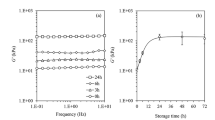Abstract
This study focused on the mechanisms of retrogradation-retardation technology for applications in garaetteok (steamed and extruded cylinder-shaped rice cake) production. Based on the comparison of conventional and retrogradation-retardation methods, the addition of raw wheat flour was selected as a key process. The rheological properties of gelatinized rice starch pastes after treatment with raw or autoclaved wheat flour and Novamyl L were investigated. Among them, raw wheat flour and Novamyl L resulted in significantly lowered the elastic modulus. The textural properties of garaetteok treated with raw or autoclaved wheat flour were examined by texture profile analysis (TPA) during storage for 3 days at 4°C. The hardness of garaetteok made with raw wheat flour was maintained for up to three days. In contrast, autoclaved wheat flour did not affect elastic modulus or hardness. As a result, raw wheat flour effectively retards starch retrogradation through starch hydrolysis induced by amylase in wheat flour.
Similar content being viewed by others
Refrerences
Yoon SJ. A literature review about characteristics of Korean rice cake by ingredients and preparation methods. Korean J. Dietary Cult. 11: 97–106 (1996)
Kum JS. Globalism and commercialization of Korean traditional rice products. Food Ind. Nutr. 6: 11–22 (2001)
Xiuting H, Xueming X, Zhengyu J, Yaoqi T, Yuxiang B, Zhengjun X. Retrogradation properties of rice starch gelatinized by heat and high hydrostatic pressure (HHP). J. Food Eng. 106: 262–266 (2011)
Seo NS, Roh SA, Auh JH, Park JH, Kim YR, Park KH. Structural characterization of rice starch in rice cake modified by Thermus scotoductus 4-alpha-glucanotransferase (TS alpha GTase). Food Chem. Toxicol. 72: 331–336 (2007)
Rosell CM, Haros M, Escrivá C, Benedito De Barber C. Experimental approach to optimize the use of alpha-amylases in breadmaking. J. Agr. Food Chem. 49: 2973–2977 (2001)
Song JC, Park HJ. Effect of starch degradation enzymes on the retrogradation of a Korean rice cakes. Korean J. Food Nutr. 32: 1262–1269 (2003)
Collar C, Andreua P, Martýìnez JC, Armero E. Optimization of hydrocolloid addition to improve wheat bread dough functionality: A response surface methodology study. Food Hydrocolloid. 13: 467–475 (1999)
Kim SS, Chung HY. Effects of carbohydrate materials on retarding retrogradation of a Korean rice cake (Karedduk). Korean J. Food Nutr. 32: 1320–1325 (2007)
Park HY, Han SY, Han GJ. Application of retrogradation-retardation technology to Korean rice cake, garaetteok made from non-waxy rice. Food Res. Int. 18: 371–374 (2012)
Koh BK. Development of the method to extend shelf life of Backsulgie with enzyme treatment. Korean J. Soc. Food Sci. 15: 533–538 (1999)
Kruger JE, Tipples KH. Relationships between falling number, amylograph viscosity and alpha-amylase activity in Canadian wheat. Cereal Res. Commun. 8: 97–105 (1980)
Forsyth SA, Koebner RMD. Wheat endosperm high molecular weight albumins and beta-amylases; genetic and electrophoretic evidence of their identity. J. Cereal Sci. 15: 137–141 (1992)
Zhang H, Shen WB, Zhang W, Xu LL. A rapid response of betaamylase to nitric oxide but not gibberellin in wheat seeds during the early stage of germination. Planta 220: 708–716 (2005)
Daba T, Kojima K, Inouye K. Characterization and solvent engineering of wheat beta-amylase for enhancing its activity and stability. Enzyme Microb. Tech. 51: 245–251 (2012)
Zhao FM, Qi X, Zhang TY, Li TJ, Bi JJ, Wang XZ. The Constructure and enzymatic characterization of isoamylase-oligomer from wheat endosperm. Agr. Sci. 44: 1077–1084 (2011)
Lee KY, Kim YR, Park KH, Lee HG. Effects of alphaglucanotransferase treatment on the thermo-reversibility and freezethaw stability of a rice starch gel. Carbohyd. Polym. 63: 347–354 (2006)
Author information
Authors and Affiliations
Corresponding author
Rights and permissions
About this article
Cite this article
Lee, J.W., Kim, H.S., Bae, I.Y. et al. Antistaling of rice starch in a gel model system and Korean rice cake: the role of wheat flour in retrogradation-retardation technology. Food Sci Biotechnol 23, 781–786 (2014). https://doi.org/10.1007/s10068-014-0105-5
Received:
Revised:
Accepted:
Published:
Issue Date:
DOI: https://doi.org/10.1007/s10068-014-0105-5




